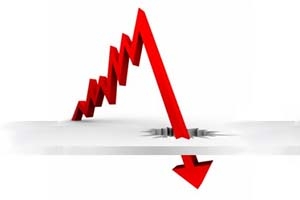
Wholesale interest rates have today pushed into record new low territory.
This caps four days of consistent declines.
For terms 3 to 10 years, rates have never been lower.
For terms 1 and 2 years, we are approaching record lows as well.
This is where we are at the end of the day (updated):
| Term | mid-day May 6, 2016 |
end-of-day May 6, 2016 |
Record low | |
| % | % | % | ||
| 1 year | 2.22 | 2.18 | 2.16 | 11-Apr-16 |
| 2 years | 2.20 | 2.16 | 2.16 | Today |
| 3 years | 2.24 | 2.19 | 2.19 | Today |
| 4 years | 2.32 | 2.27 | 2.27 | Today |
| 5 years | 2.43 | 2.38 | 2.38 | Today |
| 7 years | 2.63 | 2.59 | 2.59 | Today |
| 10 years | 2.87 | 2.83 | 2.83 | Today |
Today's dive in rates has come with a flattening bias. The 1-5 curve is now just +20 bps and the lowest/flattest since May 2015. And the more closely watched 2-10 curve is now down to +67 bps, a point it reached two weeks ago.
This story was updated with end-of-day details in the table above.
Daily swap rates
Select chart tabs
4 Comments
Making it cheaper doesn't make it productive.
Diminishing returns is the essential problem of the debt: Past a certain level of encumbrance, a marginal dollar of borrowing loses its punch.
In the not-quite half century between 1952 and 2000, $1.70 of nonfinancial borrowing sufficed to generate a dollar of GDP growth. Since 2000, $3.30 of such borrowing was the horsepower behind the same amount of growth. Which suggests, conclude Van Hoisington and Lacy Hunt in their first-quarter report to the clients of Hoisington Investment Management Co., “that the type and efficiency of the new debt is increasingly nonproductive.”
What constitutes a “nonproductive” debt? Borrowing to maintain a fig leaf of actuarial solvency would seem to fill the bill. Steven Malanga, who writes for the Manhattan Institute, reports that state and municipal pension funds boosted their indebtedness to at least $1 trillion from $233 billion between 2003 and 2013. Yet, Malanga observes, “All but a handful of state systems have higher unfunded liabilities today than in 2003.”
Neither does recent business borrowing obviously answer the definition of productive. To quote the Hoisington letter: “Last year business debt, excluding off-balance-sheet liabilities, rose $793 billion, while total gross private domestic investment (which includes fixed and inventory investment) rose only $93 billion. Thus, by inference, this debt increase went into share buybacks, dividend increases and other financial endeavors, [although] corporate cash flow declined by $224 billion. When business debt is allocated to financial operations, it does not generate an income stream to meet interest and repayment requirements. Such a usage of debt does not support economic growth, employment, higherpaying jobs or productivity growth.” Read more
Falling swaps, a weakening USD and a shrinking US trade gap driven by falling imports. Doesn't look good for US consumption does it?
5 year bank rates over 5%. Nice 100% margin for banks.
Qe4 in USA? Qe23 in Japan? PMI will be interesting charts to watch, as will unemployment numbers

We welcome your comments below. If you are not already registered, please register to comment.
Remember we welcome robust, respectful and insightful debate. We don't welcome abusive or defamatory comments and will de-register those repeatedly making such comments. Our current comment policy is here.